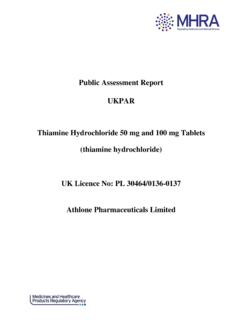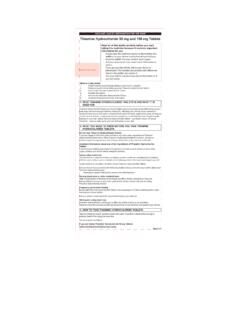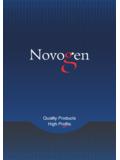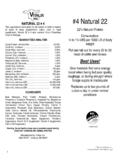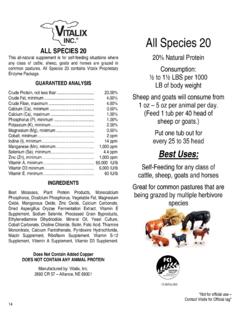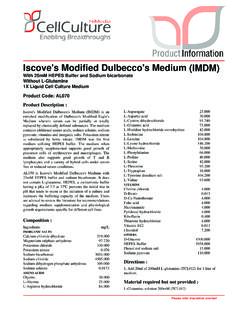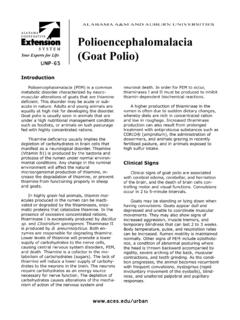Transcription of New Zealand Data Sheet APO-THIAMINE - Medsafe
1 New Zealand data Sheet APO-THIAMINE Please refer to Medsafe website ( ) for the most recent datasheet Page 1 of 5 1. APO-THIAMINE (50mg) 2. QUALITATIVE AND QUANTITATIVE COMPOSITION Name and strength of the active substance thiamine hydrochloride 50mg Excipient with known effect Lactose APO-THIAMINE contains Lactose. If you have been told by your doctor that you have an intolerance to some sugars, contact your doctor before taking this medicinal product. For a full list of excipients, see section 3. PHARMACEUTICAL FORM APO-THIAMINE 50mg tablets are white, round, 8mm in diameter, biconvex, engraved with APO on one side and THI over 50 on the other side. Each tablet contains 50mg thiamine hydrochloride and typically weighs 200mg. 4. CLINICAL PARTICULARS Therapeutic indications Prophylaxis and treatment of vitamin B1 deficiency states including beriberi and Wernicke s encephalopathy.
2 Dose and method of administration In preventing vitamin deficiencies adequate dietary intake is preferred over supplementation whenever possible. An adequate human diet in most circumstances is one containing between and vitamin B1 daily. Dose The usual adult dose to treat deficiency is 5-30mg either as a single or in divided doses. In severe thiamine deficiency including treatment of beriberi doses of up to 300mg daily in three divided doses may be given. Method of administration In severe thiamine deficiency including treatment of beriberi doses of up to 300mg daily in three divided doses may be given. Even higher daily doses may be given in Wernicke s encephalopathy although the intravenous route is usually chosen under these circumstances. APO-THIAMINE Please refer to Medsafe website ( ) for the most recent datasheet Page 2 of 5 Contraindications Hypersensitivity to vitamin B1.
3 Special warnings and precautions for use Serious sensitivity reactions can occur with deaths having resulted from use. Simple vitamin B1 deficiency is rare. Multiple vitamin deficiencies should be suspected in any case of dietary inadequacy. Interaction with other medicines and other forms of interaction None have been reported. Fertility, pregnancy and lactation Pregnancy No adverse effects have been reported with the intake of normal daily requirements during pregnancy. Breast-feeding Although thiamine appears in breast milk, no adverse effects have been reported with intake of normal daily requirements during lactation. Effects on ability to drive and use machines Presumed to be safe or unlikely to produce and effect on the ability to drive or use machinery. Undesirable effects Feeling of warmth, pruritus, urticaria, weakness, sweating, nausea, restlessness, tightness of the throat, angioneurotic oedema, cyanosis, pulmonary oedema, haemorrhage into the gastrointestinal tract, collapse and death have been rarely reported mainly following repeated administration.
4 Reporting of suspected adverse reactions Reporting suspected adverse reactions after authorisation of the medicine is important. It allows continued monitoring of the benefit/risk balance of the medicine. Healthcare professional are asked to report any suspected adverse reactions Overdose Overdosage has not been reported and intake in excess of the body s requirements is excreted in the urine. Should overdosage occur and adverse reactions result, treatment should be supportive and symptomatic. Fluid intake should be maintained. For advice on the management of overdose please contact the National Poisons Centre on 0800 POISON (0800 764766). APO-THIAMINE Please refer to Medsafe website ( ) for the most recent datasheet Page 3 of 5 5. PHARMACOLOGICAL PROPERTIES Pharmacodynamic Properties Pharmacotherapeutic group: alimentary tract and metabolism ATC code: A11DA01 Mechanism of Action thiamine hydrochloride (vitamin B1) is a water-soluble vitamin.
5 It is an essential co-enzyme for carbohydrate metabolism in the form of the diphosphate ( thiamine pyrophosphate, cocarboxylase). Its role in carbohydrate metabolism is the decarboxylation of pyruvic acid and alpha-ketoacids to acetaldehyde and carbon dioxide. Increased levels of pyruvic acid in the blood indicate vitamin B1 deficiency. thiamine deficiency can occur when dietary intake is inadequate (after approximately 3 weeks of total absence of the vitamin from the diet). Deficiency may occur in alcoholics and food faddist or in special clinical situations such as haemodialysis, chronic peritoneal dialysis, or after administration of glucose to a vitamin B1 depleted patient. Requirements may be increased due to burns, chronic fever, gastrectomy, intestinal disease, liver disease and hyperthyroidism. Deficiency of vitamin B1 eventually leads to beriberi or Wernicke s encephalopathy.
6 The cardiovascular and/or nervous system may be affected. Cardiovascular involvement is manifested by high output, biventricular heart failure and oedema. CNS symptoms include peripheral neuropathy and an encephalopathy syndrome characterised by nystagmus, ophthalmoplegia, fever, ataxia and progressive mental deterioration which may ultimately result in coma and death. Pharmacokinetic properties Small amounts of thiamine are absorbed from the gastrointestinal tract mainly from the duodenum by both active and passive processes. However absorption of doses greater than 5mg is limited. It is widely distributed to most body tissue and appears in breast milk. Body stores (as the phosphorylated form) are approximately 30mg with a 1mg daily turnover. Storage is mainly in skeletal muscles, heart, liver, kidneys and brain.
7 Amounts of thiamine in excess of the body s requirements are excreted in the urine as either unchanged thiamine or as metabolites. thiamine is metabolised in the liver. It is transformed by phosphorylation into active co-enzyme thiamine pyrophosphate. Dephosphorylation can occur in the kidneys and probably other organs and excess quantities of the free vitamin and the pyrimidine are excreted in the urine. The urinary excretion is depends in part on the urine volume and during diuresis large amounts of thiamine may be lost. Small quantities are excreted in the sweat. Preclinical safety data Not applicable APO-THIAMINE Please refer to Medsafe website ( ) for the most recent datasheet Page 4 of 5 6. PHARMACEUTICAL PARTICULARS List of excipients APO-THIAMINE 50mg tablet contains the following excipients: Lactose monohydrate Microcrystalline cellulose Magnesium stearate APO-THIAMINE 50mg contains lactose.
8 Incompatibilities Not applicable Shelf life 36 months from date of manufacture Special Precautions Store at or below 30 C Protect from heat, light and moisture. Keep the container tightly closed. Nature and contents of container APO-THIAMINE 50mg tablets: HDPE Bottles of 100 or 500 tablets Not all pack sizes maybe marketed. Special precautions for disposal No special requirements for disposal. Any unused medicine or waste material should be disposed of in accordance with local requirements. 7. MEDICINE SCHEDULE General Sale Medicine 8. SPONSOR Apotex NZ Ltd. 32 Hillside Road Glenfield AUCKLAND 0627 Telephone: (09) 444 2073 Fax: (09) 444 2951 E-mail: APO-THIAMINE Please refer to Medsafe website ( ) for the most recent datasheet Page 5 of 5 9. DATE OF FIRST APPROVAL 31 December 1969 10.
9 DATE OF REVISION OF THE TEXT 22 February 2017 Summary Table of Changes Section changed Summary of new information Whole data Sheet Reformatted as per Medsafe new data Sheet . Removal of references to10mg and 25mg strengths as the approval has lapsed. Additional information as per Medsafe requirements APO-THIAMINE contains lactose










